Critical Analysis of a Laparoscopic Cholecystectomy Case Study
VerifiedAdded on 2020/03/01
|12
|2869
|1003
Case Study
AI Summary
This case study report critically analyzes the case of Mrs. Beryl Hayes, admitted for a laparoscopic cholecystectomy. The report delves into the pathophysiology of gallstones and the surgical procedure, emphasizing the differences between open and laparoscopic methods. It provides a detailed patient assessment, considering various physiological parameters and potential complications. The discussion includes the prioritization of nursing care, highlighting essential interventions such as monitoring breathing patterns, wound care, and pain management. Furthermore, the report outlines a comprehensive discharge plan, including medication prescriptions, dietary recommendations, and follow-up instructions to ensure a smooth recovery for the patient. The report aims to provide a holistic understanding of cholecystectomy, emphasizing evidence-based practices to improve patient outcomes.
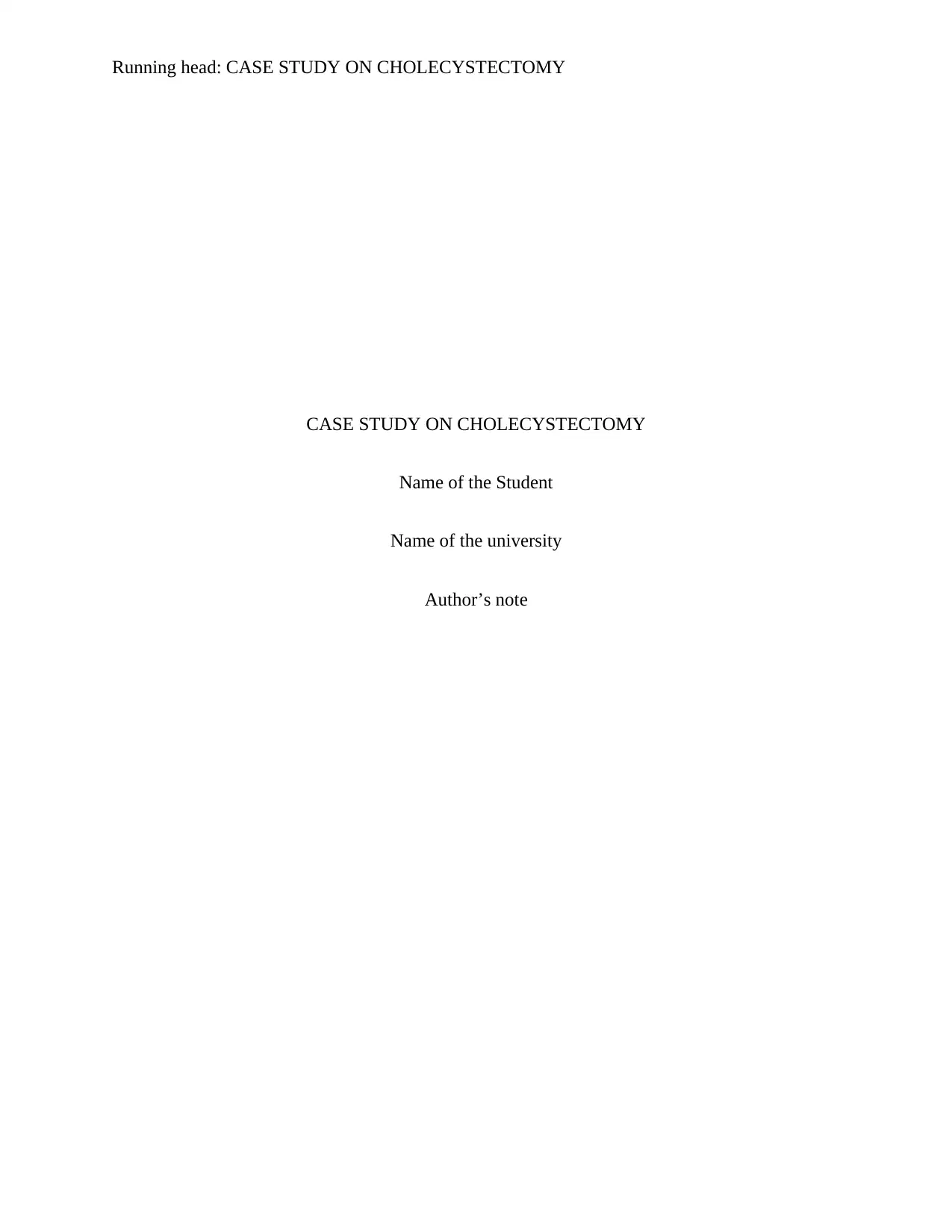
Running head: CASE STUDY ON CHOLECYSTECTOMY
CASE STUDY ON CHOLECYSTECTOMY
Name of the Student
Name of the university
Author’s note
CASE STUDY ON CHOLECYSTECTOMY
Name of the Student
Name of the university
Author’s note
Paraphrase This Document
Need a fresh take? Get an instant paraphrase of this document with our AI Paraphraser
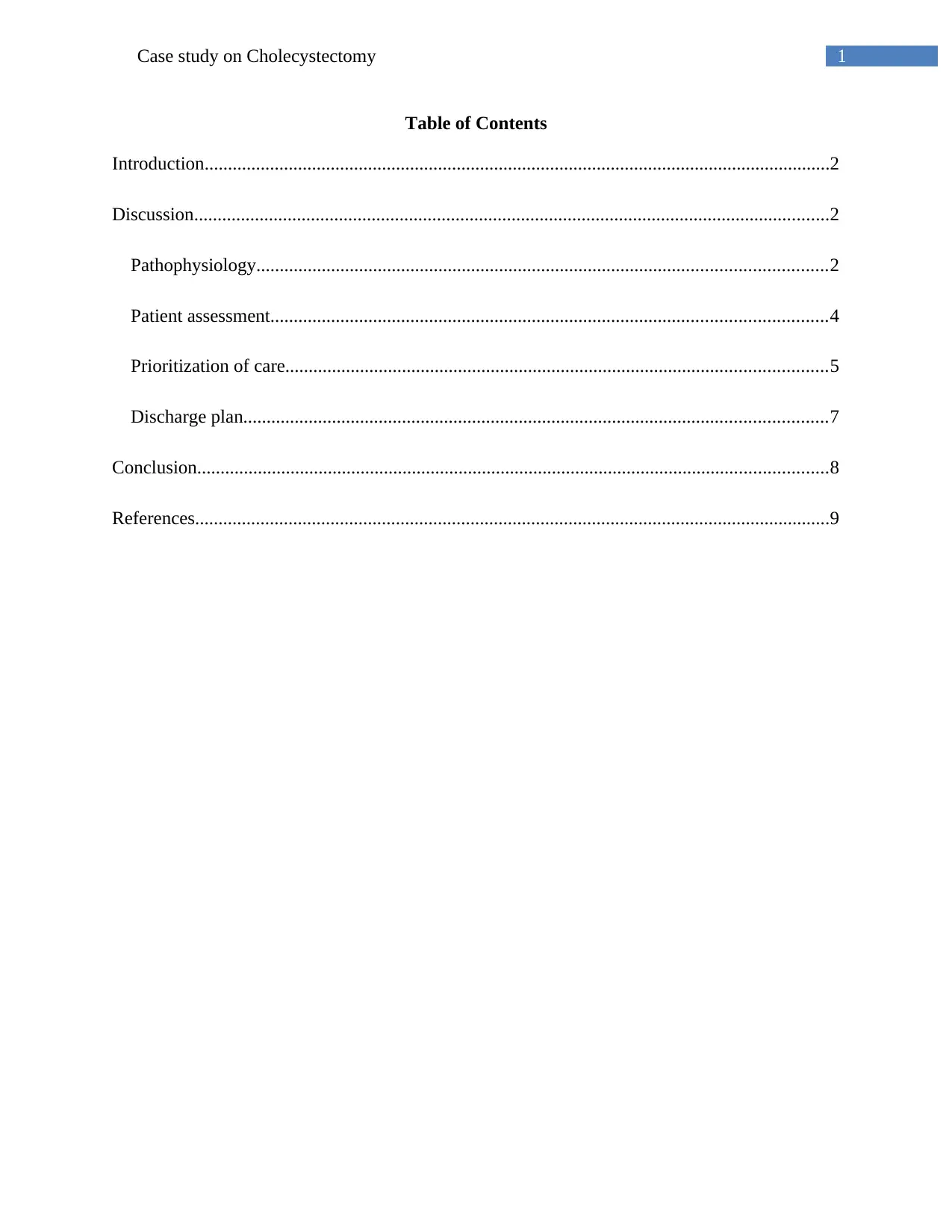
1Case study on Cholecystectomy
Table of Contents
Introduction......................................................................................................................................2
Discussion........................................................................................................................................2
Pathophysiology..........................................................................................................................2
Patient assessment.......................................................................................................................4
Prioritization of care....................................................................................................................5
Discharge plan.............................................................................................................................7
Conclusion.......................................................................................................................................8
References........................................................................................................................................9
Table of Contents
Introduction......................................................................................................................................2
Discussion........................................................................................................................................2
Pathophysiology..........................................................................................................................2
Patient assessment.......................................................................................................................4
Prioritization of care....................................................................................................................5
Discharge plan.............................................................................................................................7
Conclusion.......................................................................................................................................8
References........................................................................................................................................9

2Case study on Cholecystectomy
Introduction
This report aims to critically analyze the case study of Mrs. Beryl Hayes, who has been
admitted to the ward for a laproscopic cholecystectomy. Beryl has undergone a surgery and is
now still in the hospital. She has not been discharged from the hospital as no improvement is
seen in her condition, and already 3 days had already passed by after the surgery.
Laparoscopic cholecystectomy is usually done to remove the gall stones from the gall
bladder. This process involves two methods- Open cholecystectomy and laparoscopic
cholcystectomy. This report has focused on the laparoscopic method as per the given case study.
This report will be discussing about the physiology and the pathophysiology of her
conditions. Assessment has been done depending on the evidence based practice. The latter part
of the discussion also throws light upon the type of care that has to be provided to the patient.
The report also discusses about the discharge plan that has to be prepared for the patient and help
him to return to his daily activities with ease.
Discussion
Pathophysiology
Laparoscopic cholesystectomy is usually done to remove the gall bladder. It is usually
done it patients, who have developed stones or infections in the gall bladder. Normally after a
cholecystectomy, a person is unable to go home, the same day, but is generally discharged after a
one night stay. Post operative complications may arise which can extend the stay in the hospital.
Introduction
This report aims to critically analyze the case study of Mrs. Beryl Hayes, who has been
admitted to the ward for a laproscopic cholecystectomy. Beryl has undergone a surgery and is
now still in the hospital. She has not been discharged from the hospital as no improvement is
seen in her condition, and already 3 days had already passed by after the surgery.
Laparoscopic cholecystectomy is usually done to remove the gall stones from the gall
bladder. This process involves two methods- Open cholecystectomy and laparoscopic
cholcystectomy. This report has focused on the laparoscopic method as per the given case study.
This report will be discussing about the physiology and the pathophysiology of her
conditions. Assessment has been done depending on the evidence based practice. The latter part
of the discussion also throws light upon the type of care that has to be provided to the patient.
The report also discusses about the discharge plan that has to be prepared for the patient and help
him to return to his daily activities with ease.
Discussion
Pathophysiology
Laparoscopic cholesystectomy is usually done to remove the gall bladder. It is usually
done it patients, who have developed stones or infections in the gall bladder. Normally after a
cholecystectomy, a person is unable to go home, the same day, but is generally discharged after a
one night stay. Post operative complications may arise which can extend the stay in the hospital.
⊘ This is a preview!⊘
Do you want full access?
Subscribe today to unlock all pages.

Trusted by 1+ million students worldwide
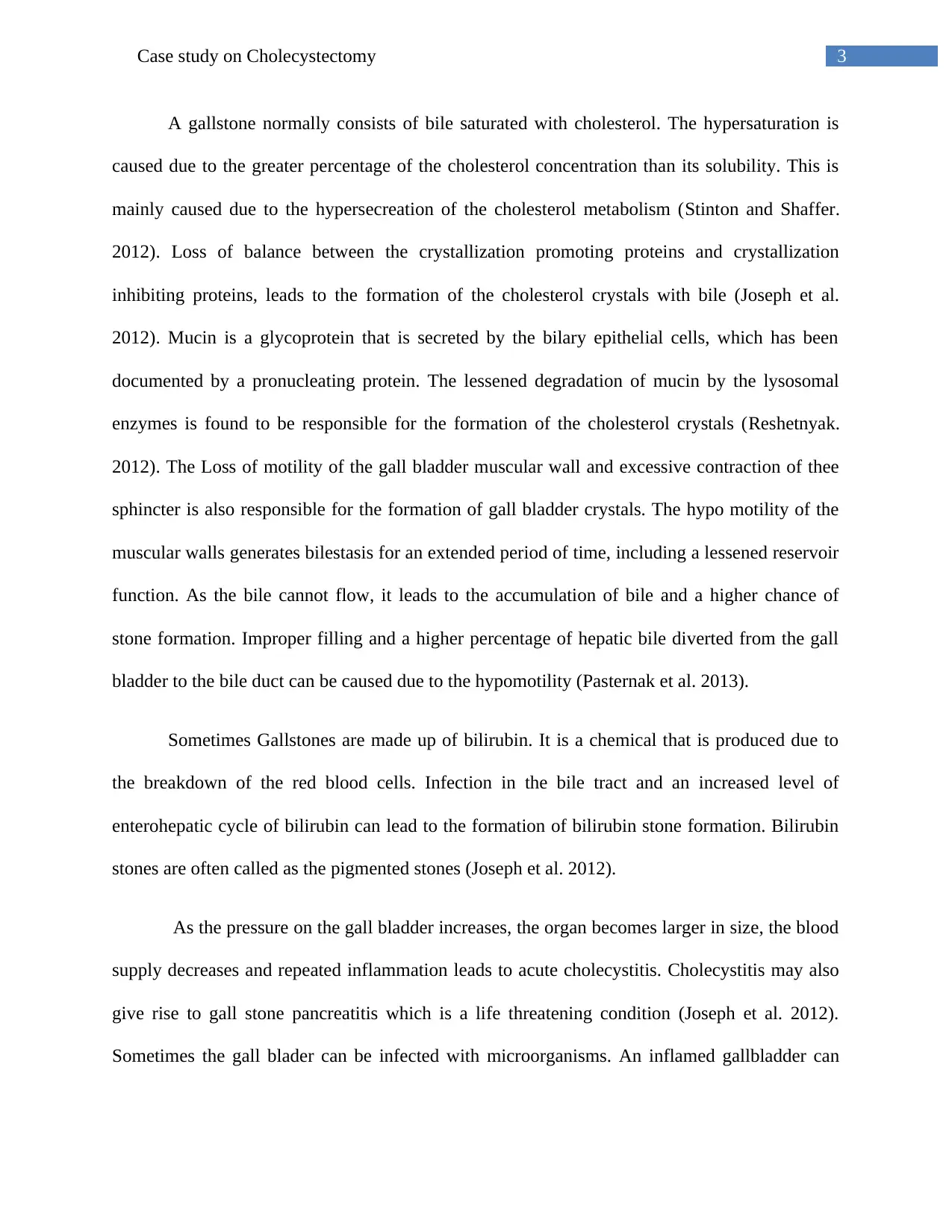
3Case study on Cholecystectomy
A gallstone normally consists of bile saturated with cholesterol. The hypersaturation is
caused due to the greater percentage of the cholesterol concentration than its solubility. This is
mainly caused due to the hypersecreation of the cholesterol metabolism (Stinton and Shaffer.
2012). Loss of balance between the crystallization promoting proteins and crystallization
inhibiting proteins, leads to the formation of the cholesterol crystals with bile (Joseph et al.
2012). Mucin is a glycoprotein that is secreted by the bilary epithelial cells, which has been
documented by a pronucleating protein. The lessened degradation of mucin by the lysosomal
enzymes is found to be responsible for the formation of the cholesterol crystals (Reshetnyak.
2012). The Loss of motility of the gall bladder muscular wall and excessive contraction of thee
sphincter is also responsible for the formation of gall bladder crystals. The hypo motility of the
muscular walls generates bilestasis for an extended period of time, including a lessened reservoir
function. As the bile cannot flow, it leads to the accumulation of bile and a higher chance of
stone formation. Improper filling and a higher percentage of hepatic bile diverted from the gall
bladder to the bile duct can be caused due to the hypomotility (Pasternak et al. 2013).
Sometimes Gallstones are made up of bilirubin. It is a chemical that is produced due to
the breakdown of the red blood cells. Infection in the bile tract and an increased level of
enterohepatic cycle of bilirubin can lead to the formation of bilirubin stone formation. Bilirubin
stones are often called as the pigmented stones (Joseph et al. 2012).
As the pressure on the gall bladder increases, the organ becomes larger in size, the blood
supply decreases and repeated inflammation leads to acute cholecystitis. Cholecystitis may also
give rise to gall stone pancreatitis which is a life threatening condition (Joseph et al. 2012).
Sometimes the gall blader can be infected with microorganisms. An inflamed gallbladder can
A gallstone normally consists of bile saturated with cholesterol. The hypersaturation is
caused due to the greater percentage of the cholesterol concentration than its solubility. This is
mainly caused due to the hypersecreation of the cholesterol metabolism (Stinton and Shaffer.
2012). Loss of balance between the crystallization promoting proteins and crystallization
inhibiting proteins, leads to the formation of the cholesterol crystals with bile (Joseph et al.
2012). Mucin is a glycoprotein that is secreted by the bilary epithelial cells, which has been
documented by a pronucleating protein. The lessened degradation of mucin by the lysosomal
enzymes is found to be responsible for the formation of the cholesterol crystals (Reshetnyak.
2012). The Loss of motility of the gall bladder muscular wall and excessive contraction of thee
sphincter is also responsible for the formation of gall bladder crystals. The hypo motility of the
muscular walls generates bilestasis for an extended period of time, including a lessened reservoir
function. As the bile cannot flow, it leads to the accumulation of bile and a higher chance of
stone formation. Improper filling and a higher percentage of hepatic bile diverted from the gall
bladder to the bile duct can be caused due to the hypomotility (Pasternak et al. 2013).
Sometimes Gallstones are made up of bilirubin. It is a chemical that is produced due to
the breakdown of the red blood cells. Infection in the bile tract and an increased level of
enterohepatic cycle of bilirubin can lead to the formation of bilirubin stone formation. Bilirubin
stones are often called as the pigmented stones (Joseph et al. 2012).
As the pressure on the gall bladder increases, the organ becomes larger in size, the blood
supply decreases and repeated inflammation leads to acute cholecystitis. Cholecystitis may also
give rise to gall stone pancreatitis which is a life threatening condition (Joseph et al. 2012).
Sometimes the gall blader can be infected with microorganisms. An inflamed gallbladder can
Paraphrase This Document
Need a fresh take? Get an instant paraphrase of this document with our AI Paraphraser
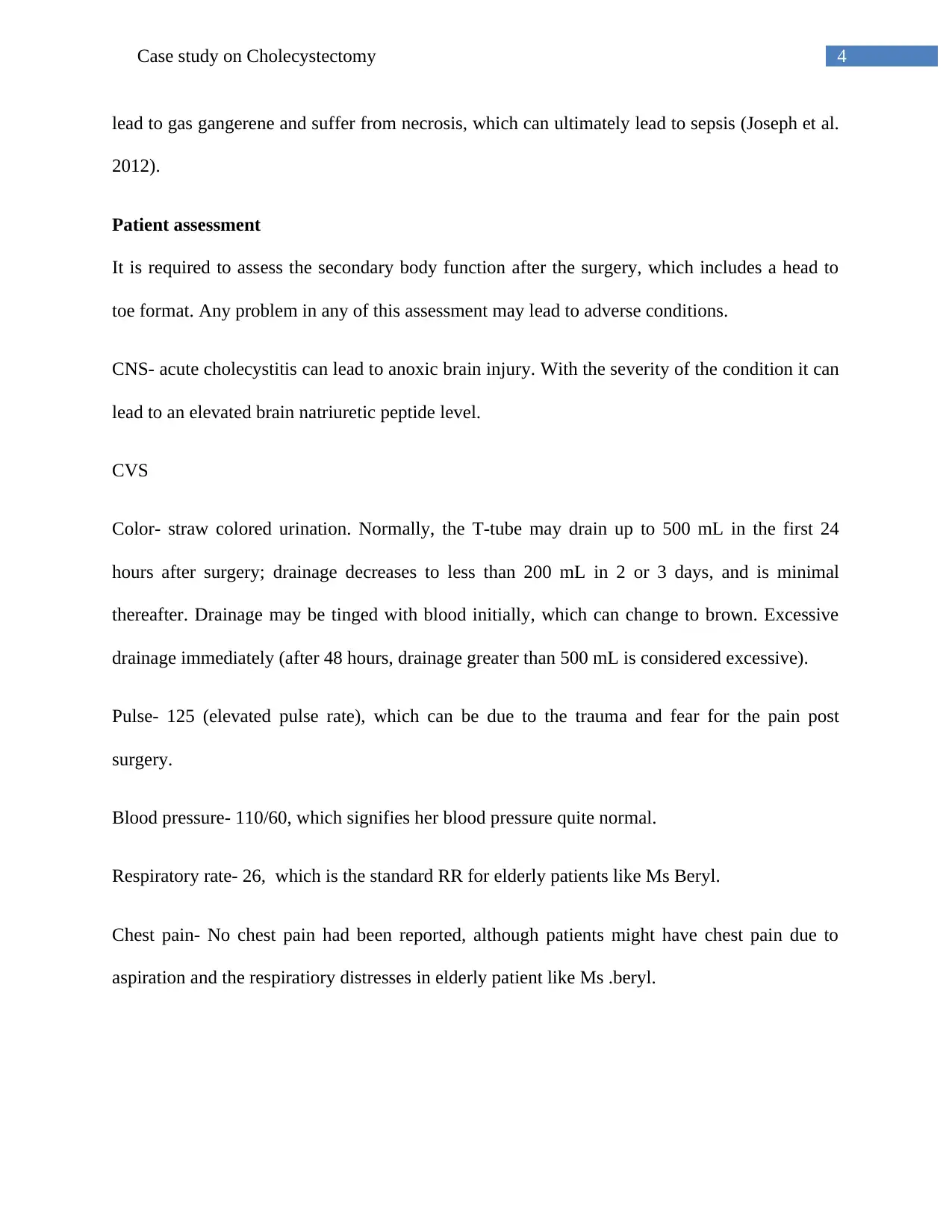
4Case study on Cholecystectomy
lead to gas gangerene and suffer from necrosis, which can ultimately lead to sepsis (Joseph et al.
2012).
Patient assessment
It is required to assess the secondary body function after the surgery, which includes a head to
toe format. Any problem in any of this assessment may lead to adverse conditions.
CNS- acute cholecystitis can lead to anoxic brain injury. With the severity of the condition it can
lead to an elevated brain natriuretic peptide level.
CVS
Color- straw colored urination. Normally, the T-tube may drain up to 500 mL in the first 24
hours after surgery; drainage decreases to less than 200 mL in 2 or 3 days, and is minimal
thereafter. Drainage may be tinged with blood initially, which can change to brown. Excessive
drainage immediately (after 48 hours, drainage greater than 500 mL is considered excessive).
Pulse- 125 (elevated pulse rate), which can be due to the trauma and fear for the pain post
surgery.
Blood pressure- 110/60, which signifies her blood pressure quite normal.
Respiratory rate- 26, which is the standard RR for elderly patients like Ms Beryl.
Chest pain- No chest pain had been reported, although patients might have chest pain due to
aspiration and the respiratiory distresses in elderly patient like Ms .beryl.
lead to gas gangerene and suffer from necrosis, which can ultimately lead to sepsis (Joseph et al.
2012).
Patient assessment
It is required to assess the secondary body function after the surgery, which includes a head to
toe format. Any problem in any of this assessment may lead to adverse conditions.
CNS- acute cholecystitis can lead to anoxic brain injury. With the severity of the condition it can
lead to an elevated brain natriuretic peptide level.
CVS
Color- straw colored urination. Normally, the T-tube may drain up to 500 mL in the first 24
hours after surgery; drainage decreases to less than 200 mL in 2 or 3 days, and is minimal
thereafter. Drainage may be tinged with blood initially, which can change to brown. Excessive
drainage immediately (after 48 hours, drainage greater than 500 mL is considered excessive).
Pulse- 125 (elevated pulse rate), which can be due to the trauma and fear for the pain post
surgery.
Blood pressure- 110/60, which signifies her blood pressure quite normal.
Respiratory rate- 26, which is the standard RR for elderly patients like Ms Beryl.
Chest pain- No chest pain had been reported, although patients might have chest pain due to
aspiration and the respiratiory distresses in elderly patient like Ms .beryl.
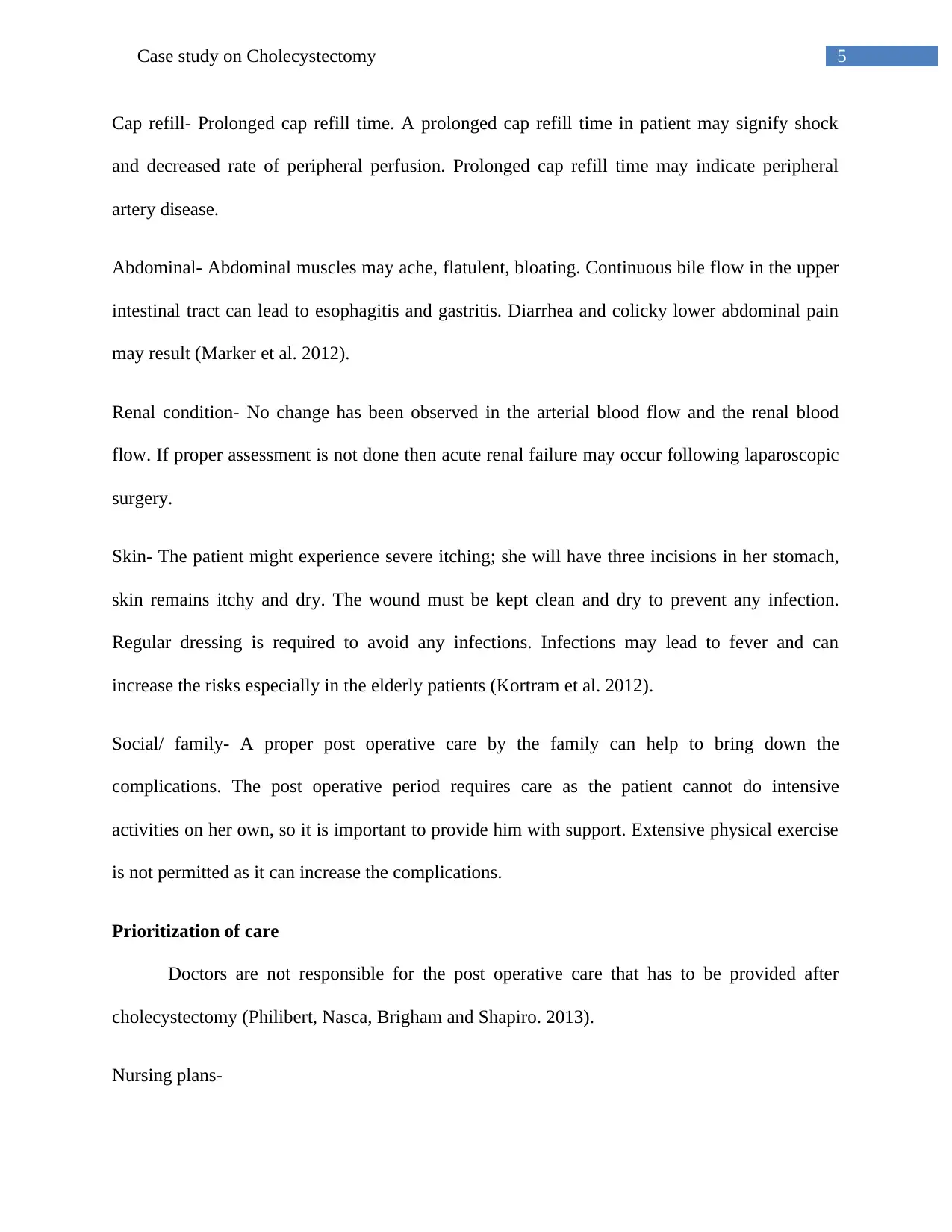
5Case study on Cholecystectomy
Cap refill- Prolonged cap refill time. A prolonged cap refill time in patient may signify shock
and decreased rate of peripheral perfusion. Prolonged cap refill time may indicate peripheral
artery disease.
Abdominal- Abdominal muscles may ache, flatulent, bloating. Continuous bile flow in the upper
intestinal tract can lead to esophagitis and gastritis. Diarrhea and colicky lower abdominal pain
may result (Marker et al. 2012).
Renal condition- No change has been observed in the arterial blood flow and the renal blood
flow. If proper assessment is not done then acute renal failure may occur following laparoscopic
surgery.
Skin- The patient might experience severe itching; she will have three incisions in her stomach,
skin remains itchy and dry. The wound must be kept clean and dry to prevent any infection.
Regular dressing is required to avoid any infections. Infections may lead to fever and can
increase the risks especially in the elderly patients (Kortram et al. 2012).
Social/ family- A proper post operative care by the family can help to bring down the
complications. The post operative period requires care as the patient cannot do intensive
activities on her own, so it is important to provide him with support. Extensive physical exercise
is not permitted as it can increase the complications.
Prioritization of care
Doctors are not responsible for the post operative care that has to be provided after
cholecystectomy (Philibert, Nasca, Brigham and Shapiro. 2013).
Nursing plans-
Cap refill- Prolonged cap refill time. A prolonged cap refill time in patient may signify shock
and decreased rate of peripheral perfusion. Prolonged cap refill time may indicate peripheral
artery disease.
Abdominal- Abdominal muscles may ache, flatulent, bloating. Continuous bile flow in the upper
intestinal tract can lead to esophagitis and gastritis. Diarrhea and colicky lower abdominal pain
may result (Marker et al. 2012).
Renal condition- No change has been observed in the arterial blood flow and the renal blood
flow. If proper assessment is not done then acute renal failure may occur following laparoscopic
surgery.
Skin- The patient might experience severe itching; she will have three incisions in her stomach,
skin remains itchy and dry. The wound must be kept clean and dry to prevent any infection.
Regular dressing is required to avoid any infections. Infections may lead to fever and can
increase the risks especially in the elderly patients (Kortram et al. 2012).
Social/ family- A proper post operative care by the family can help to bring down the
complications. The post operative period requires care as the patient cannot do intensive
activities on her own, so it is important to provide him with support. Extensive physical exercise
is not permitted as it can increase the complications.
Prioritization of care
Doctors are not responsible for the post operative care that has to be provided after
cholecystectomy (Philibert, Nasca, Brigham and Shapiro. 2013).
Nursing plans-
⊘ This is a preview!⊘
Do you want full access?
Subscribe today to unlock all pages.

Trusted by 1+ million students worldwide
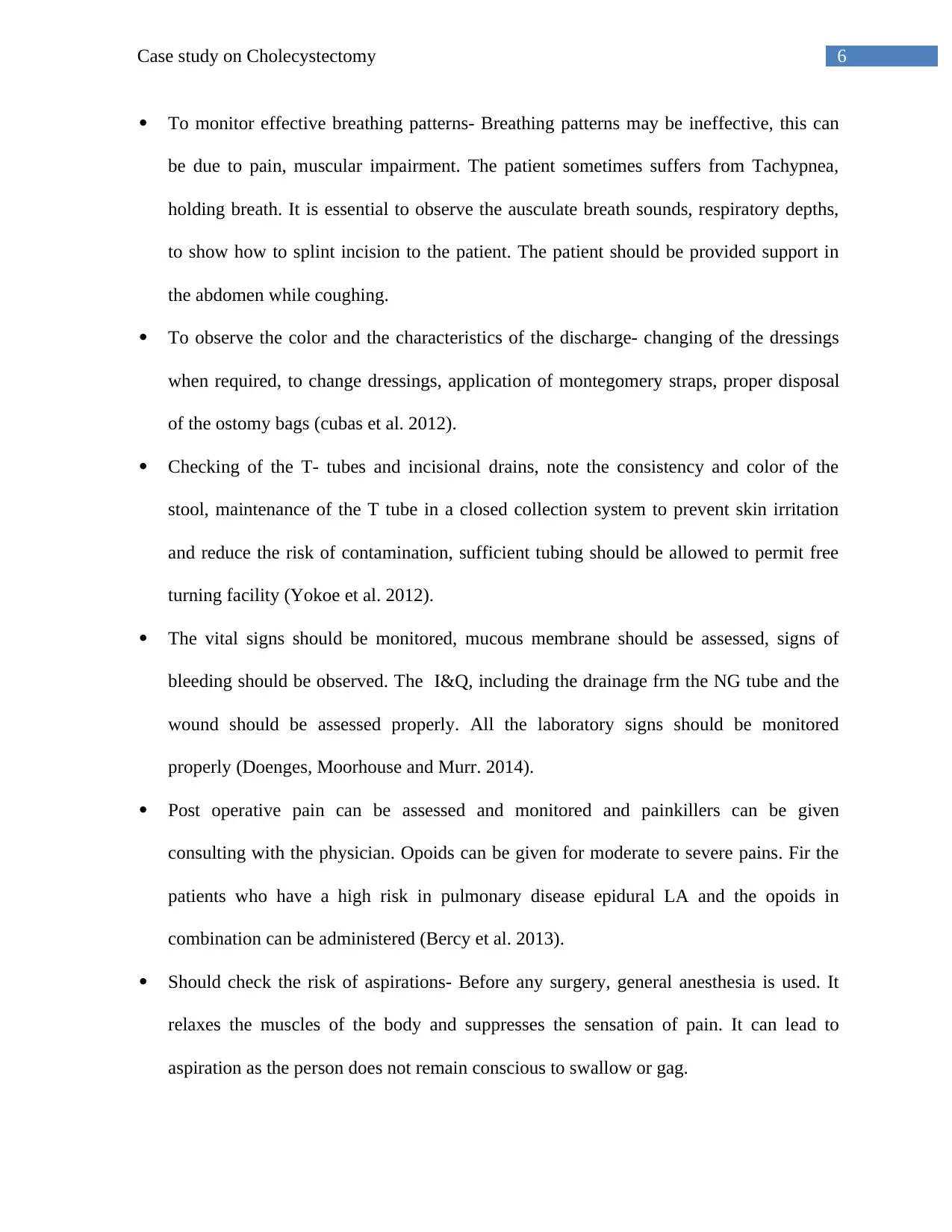
6Case study on Cholecystectomy
To monitor effective breathing patterns- Breathing patterns may be ineffective, this can
be due to pain, muscular impairment. The patient sometimes suffers from Tachypnea,
holding breath. It is essential to observe the ausculate breath sounds, respiratory depths,
to show how to splint incision to the patient. The patient should be provided support in
the abdomen while coughing.
To observe the color and the characteristics of the discharge- changing of the dressings
when required, to change dressings, application of montegomery straps, proper disposal
of the ostomy bags (cubas et al. 2012).
Checking of the T- tubes and incisional drains, note the consistency and color of the
stool, maintenance of the T tube in a closed collection system to prevent skin irritation
and reduce the risk of contamination, sufficient tubing should be allowed to permit free
turning facility (Yokoe et al. 2012).
The vital signs should be monitored, mucous membrane should be assessed, signs of
bleeding should be observed. The I&Q, including the drainage frm the NG tube and the
wound should be assessed properly. All the laboratory signs should be monitored
properly (Doenges, Moorhouse and Murr. 2014).
Post operative pain can be assessed and monitored and painkillers can be given
consulting with the physician. Opoids can be given for moderate to severe pains. Fir the
patients who have a high risk in pulmonary disease epidural LA and the opoids in
combination can be administered (Bercy et al. 2013).
Should check the risk of aspirations- Before any surgery, general anesthesia is used. It
relaxes the muscles of the body and suppresses the sensation of pain. It can lead to
aspiration as the person does not remain conscious to swallow or gag.
To monitor effective breathing patterns- Breathing patterns may be ineffective, this can
be due to pain, muscular impairment. The patient sometimes suffers from Tachypnea,
holding breath. It is essential to observe the ausculate breath sounds, respiratory depths,
to show how to splint incision to the patient. The patient should be provided support in
the abdomen while coughing.
To observe the color and the characteristics of the discharge- changing of the dressings
when required, to change dressings, application of montegomery straps, proper disposal
of the ostomy bags (cubas et al. 2012).
Checking of the T- tubes and incisional drains, note the consistency and color of the
stool, maintenance of the T tube in a closed collection system to prevent skin irritation
and reduce the risk of contamination, sufficient tubing should be allowed to permit free
turning facility (Yokoe et al. 2012).
The vital signs should be monitored, mucous membrane should be assessed, signs of
bleeding should be observed. The I&Q, including the drainage frm the NG tube and the
wound should be assessed properly. All the laboratory signs should be monitored
properly (Doenges, Moorhouse and Murr. 2014).
Post operative pain can be assessed and monitored and painkillers can be given
consulting with the physician. Opoids can be given for moderate to severe pains. Fir the
patients who have a high risk in pulmonary disease epidural LA and the opoids in
combination can be administered (Bercy et al. 2013).
Should check the risk of aspirations- Before any surgery, general anesthesia is used. It
relaxes the muscles of the body and suppresses the sensation of pain. It can lead to
aspiration as the person does not remain conscious to swallow or gag.
Paraphrase This Document
Need a fresh take? Get an instant paraphrase of this document with our AI Paraphraser
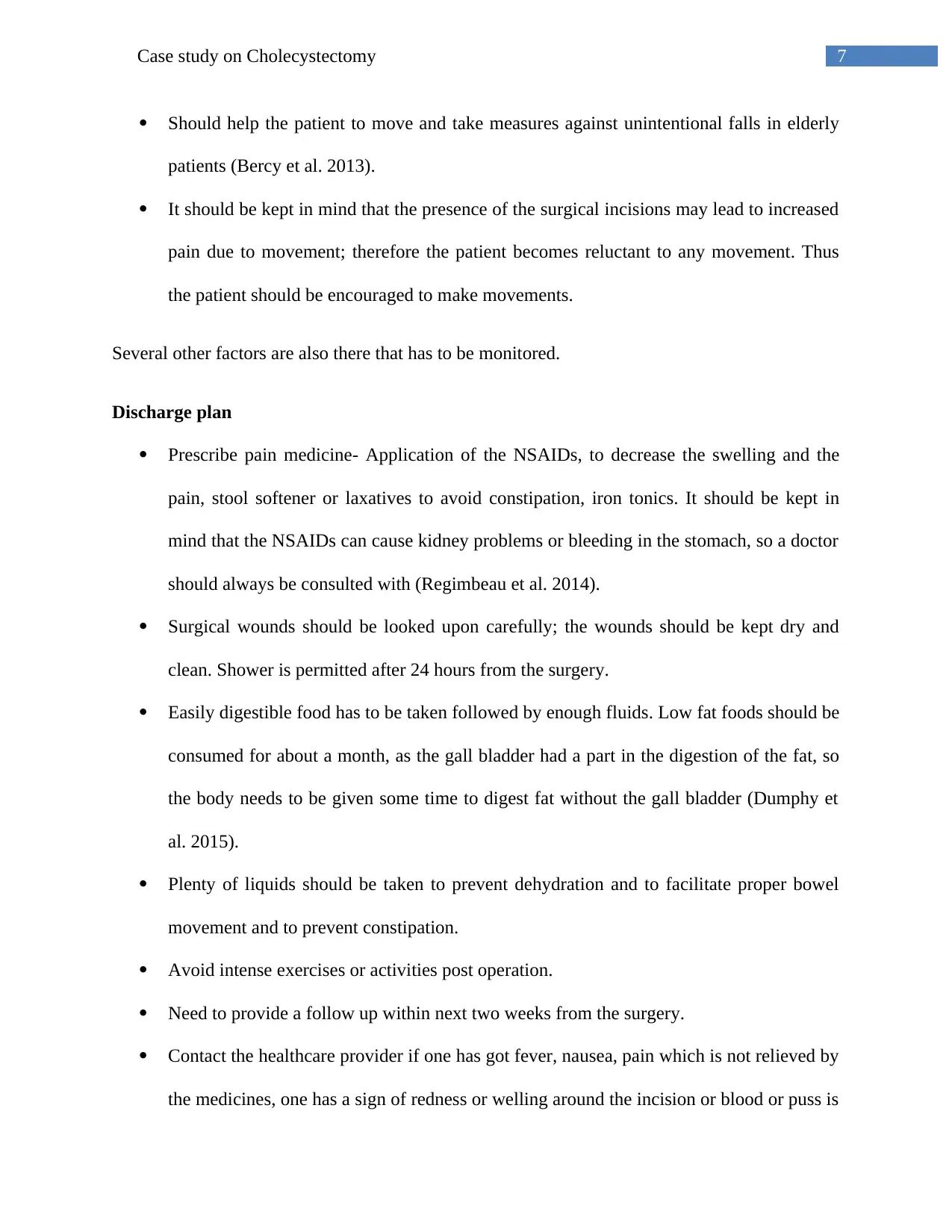
7Case study on Cholecystectomy
Should help the patient to move and take measures against unintentional falls in elderly
patients (Bercy et al. 2013).
It should be kept in mind that the presence of the surgical incisions may lead to increased
pain due to movement; therefore the patient becomes reluctant to any movement. Thus
the patient should be encouraged to make movements.
Several other factors are also there that has to be monitored.
Discharge plan
Prescribe pain medicine- Application of the NSAIDs, to decrease the swelling and the
pain, stool softener or laxatives to avoid constipation, iron tonics. It should be kept in
mind that the NSAIDs can cause kidney problems or bleeding in the stomach, so a doctor
should always be consulted with (Regimbeau et al. 2014).
Surgical wounds should be looked upon carefully; the wounds should be kept dry and
clean. Shower is permitted after 24 hours from the surgery.
Easily digestible food has to be taken followed by enough fluids. Low fat foods should be
consumed for about a month, as the gall bladder had a part in the digestion of the fat, so
the body needs to be given some time to digest fat without the gall bladder (Dumphy et
al. 2015).
Plenty of liquids should be taken to prevent dehydration and to facilitate proper bowel
movement and to prevent constipation.
Avoid intense exercises or activities post operation.
Need to provide a follow up within next two weeks from the surgery.
Contact the healthcare provider if one has got fever, nausea, pain which is not relieved by
the medicines, one has a sign of redness or welling around the incision or blood or puss is
Should help the patient to move and take measures against unintentional falls in elderly
patients (Bercy et al. 2013).
It should be kept in mind that the presence of the surgical incisions may lead to increased
pain due to movement; therefore the patient becomes reluctant to any movement. Thus
the patient should be encouraged to make movements.
Several other factors are also there that has to be monitored.
Discharge plan
Prescribe pain medicine- Application of the NSAIDs, to decrease the swelling and the
pain, stool softener or laxatives to avoid constipation, iron tonics. It should be kept in
mind that the NSAIDs can cause kidney problems or bleeding in the stomach, so a doctor
should always be consulted with (Regimbeau et al. 2014).
Surgical wounds should be looked upon carefully; the wounds should be kept dry and
clean. Shower is permitted after 24 hours from the surgery.
Easily digestible food has to be taken followed by enough fluids. Low fat foods should be
consumed for about a month, as the gall bladder had a part in the digestion of the fat, so
the body needs to be given some time to digest fat without the gall bladder (Dumphy et
al. 2015).
Plenty of liquids should be taken to prevent dehydration and to facilitate proper bowel
movement and to prevent constipation.
Avoid intense exercises or activities post operation.
Need to provide a follow up within next two weeks from the surgery.
Contact the healthcare provider if one has got fever, nausea, pain which is not relieved by
the medicines, one has a sign of redness or welling around the incision or blood or puss is
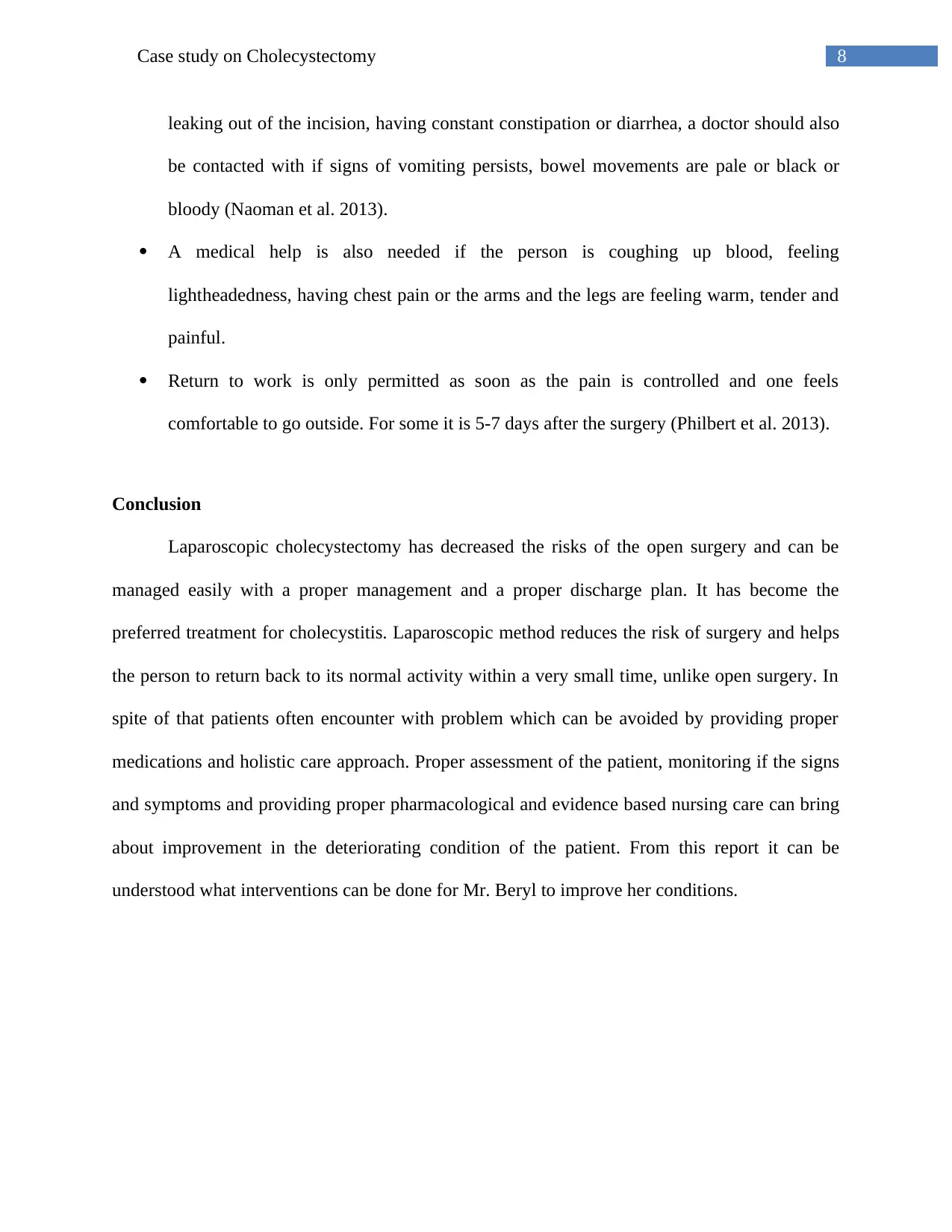
8Case study on Cholecystectomy
leaking out of the incision, having constant constipation or diarrhea, a doctor should also
be contacted with if signs of vomiting persists, bowel movements are pale or black or
bloody (Naoman et al. 2013).
A medical help is also needed if the person is coughing up blood, feeling
lightheadedness, having chest pain or the arms and the legs are feeling warm, tender and
painful.
Return to work is only permitted as soon as the pain is controlled and one feels
comfortable to go outside. For some it is 5-7 days after the surgery (Philbert et al. 2013).
Conclusion
Laparoscopic cholecystectomy has decreased the risks of the open surgery and can be
managed easily with a proper management and a proper discharge plan. It has become the
preferred treatment for cholecystitis. Laparoscopic method reduces the risk of surgery and helps
the person to return back to its normal activity within a very small time, unlike open surgery. In
spite of that patients often encounter with problem which can be avoided by providing proper
medications and holistic care approach. Proper assessment of the patient, monitoring if the signs
and symptoms and providing proper pharmacological and evidence based nursing care can bring
about improvement in the deteriorating condition of the patient. From this report it can be
understood what interventions can be done for Mr. Beryl to improve her conditions.
leaking out of the incision, having constant constipation or diarrhea, a doctor should also
be contacted with if signs of vomiting persists, bowel movements are pale or black or
bloody (Naoman et al. 2013).
A medical help is also needed if the person is coughing up blood, feeling
lightheadedness, having chest pain or the arms and the legs are feeling warm, tender and
painful.
Return to work is only permitted as soon as the pain is controlled and one feels
comfortable to go outside. For some it is 5-7 days after the surgery (Philbert et al. 2013).
Conclusion
Laparoscopic cholecystectomy has decreased the risks of the open surgery and can be
managed easily with a proper management and a proper discharge plan. It has become the
preferred treatment for cholecystitis. Laparoscopic method reduces the risk of surgery and helps
the person to return back to its normal activity within a very small time, unlike open surgery. In
spite of that patients often encounter with problem which can be avoided by providing proper
medications and holistic care approach. Proper assessment of the patient, monitoring if the signs
and symptoms and providing proper pharmacological and evidence based nursing care can bring
about improvement in the deteriorating condition of the patient. From this report it can be
understood what interventions can be done for Mr. Beryl to improve her conditions.
⊘ This is a preview!⊘
Do you want full access?
Subscribe today to unlock all pages.

Trusted by 1+ million students worldwide
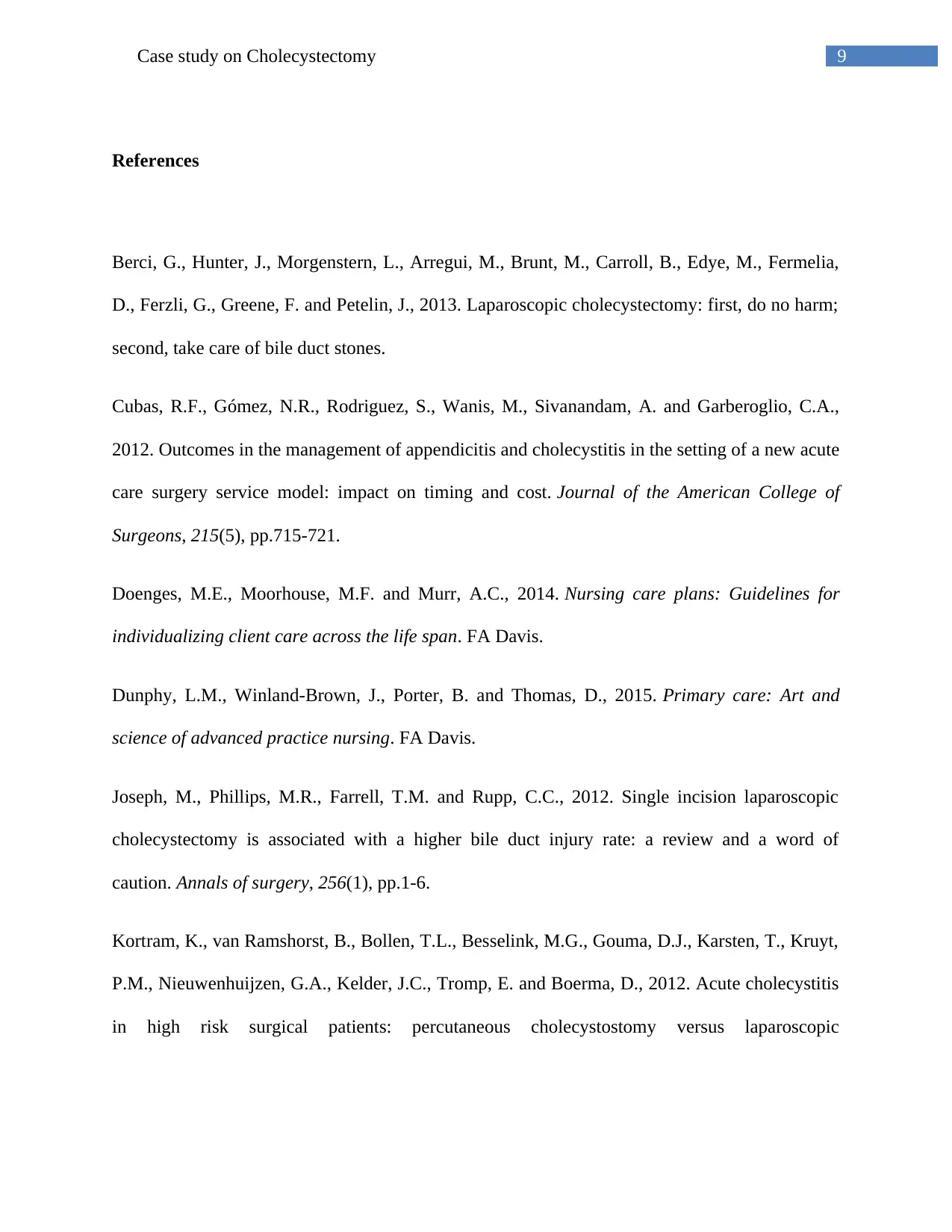
9Case study on Cholecystectomy
References
Berci, G., Hunter, J., Morgenstern, L., Arregui, M., Brunt, M., Carroll, B., Edye, M., Fermelia,
D., Ferzli, G., Greene, F. and Petelin, J., 2013. Laparoscopic cholecystectomy: first, do no harm;
second, take care of bile duct stones.
Cubas, R.F., Gómez, N.R., Rodriguez, S., Wanis, M., Sivanandam, A. and Garberoglio, C.A.,
2012. Outcomes in the management of appendicitis and cholecystitis in the setting of a new acute
care surgery service model: impact on timing and cost. Journal of the American College of
Surgeons, 215(5), pp.715-721.
Doenges, M.E., Moorhouse, M.F. and Murr, A.C., 2014. Nursing care plans: Guidelines for
individualizing client care across the life span. FA Davis.
Dunphy, L.M., Winland-Brown, J., Porter, B. and Thomas, D., 2015. Primary care: Art and
science of advanced practice nursing. FA Davis.
Joseph, M., Phillips, M.R., Farrell, T.M. and Rupp, C.C., 2012. Single incision laparoscopic
cholecystectomy is associated with a higher bile duct injury rate: a review and a word of
caution. Annals of surgery, 256(1), pp.1-6.
Kortram, K., van Ramshorst, B., Bollen, T.L., Besselink, M.G., Gouma, D.J., Karsten, T., Kruyt,
P.M., Nieuwenhuijzen, G.A., Kelder, J.C., Tromp, E. and Boerma, D., 2012. Acute cholecystitis
in high risk surgical patients: percutaneous cholecystostomy versus laparoscopic
References
Berci, G., Hunter, J., Morgenstern, L., Arregui, M., Brunt, M., Carroll, B., Edye, M., Fermelia,
D., Ferzli, G., Greene, F. and Petelin, J., 2013. Laparoscopic cholecystectomy: first, do no harm;
second, take care of bile duct stones.
Cubas, R.F., Gómez, N.R., Rodriguez, S., Wanis, M., Sivanandam, A. and Garberoglio, C.A.,
2012. Outcomes in the management of appendicitis and cholecystitis in the setting of a new acute
care surgery service model: impact on timing and cost. Journal of the American College of
Surgeons, 215(5), pp.715-721.
Doenges, M.E., Moorhouse, M.F. and Murr, A.C., 2014. Nursing care plans: Guidelines for
individualizing client care across the life span. FA Davis.
Dunphy, L.M., Winland-Brown, J., Porter, B. and Thomas, D., 2015. Primary care: Art and
science of advanced practice nursing. FA Davis.
Joseph, M., Phillips, M.R., Farrell, T.M. and Rupp, C.C., 2012. Single incision laparoscopic
cholecystectomy is associated with a higher bile duct injury rate: a review and a word of
caution. Annals of surgery, 256(1), pp.1-6.
Kortram, K., van Ramshorst, B., Bollen, T.L., Besselink, M.G., Gouma, D.J., Karsten, T., Kruyt,
P.M., Nieuwenhuijzen, G.A., Kelder, J.C., Tromp, E. and Boerma, D., 2012. Acute cholecystitis
in high risk surgical patients: percutaneous cholecystostomy versus laparoscopic
Paraphrase This Document
Need a fresh take? Get an instant paraphrase of this document with our AI Paraphraser
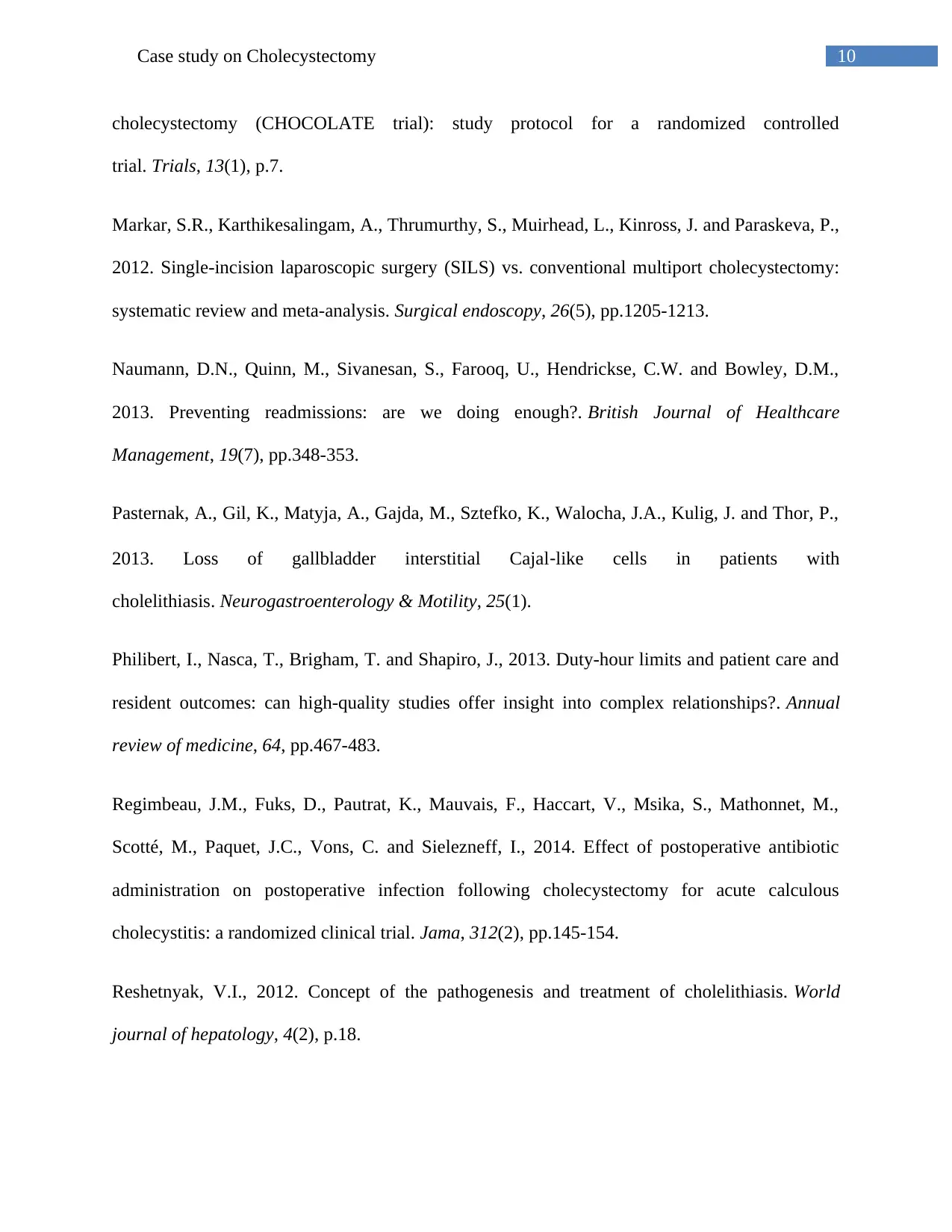
10Case study on Cholecystectomy
cholecystectomy (CHOCOLATE trial): study protocol for a randomized controlled
trial. Trials, 13(1), p.7.
Markar, S.R., Karthikesalingam, A., Thrumurthy, S., Muirhead, L., Kinross, J. and Paraskeva, P.,
2012. Single-incision laparoscopic surgery (SILS) vs. conventional multiport cholecystectomy:
systematic review and meta-analysis. Surgical endoscopy, 26(5), pp.1205-1213.
Naumann, D.N., Quinn, M., Sivanesan, S., Farooq, U., Hendrickse, C.W. and Bowley, D.M.,
2013. Preventing readmissions: are we doing enough?. British Journal of Healthcare
Management, 19(7), pp.348-353.
Pasternak, A., Gil, K., Matyja, A., Gajda, M., Sztefko, K., Walocha, J.A., Kulig, J. and Thor, P.,
2013. Loss of gallbladder interstitial Cajal‐like cells in patients with
cholelithiasis. Neurogastroenterology & Motility, 25(1).
Philibert, I., Nasca, T., Brigham, T. and Shapiro, J., 2013. Duty-hour limits and patient care and
resident outcomes: can high-quality studies offer insight into complex relationships?. Annual
review of medicine, 64, pp.467-483.
Regimbeau, J.M., Fuks, D., Pautrat, K., Mauvais, F., Haccart, V., Msika, S., Mathonnet, M.,
Scotté, M., Paquet, J.C., Vons, C. and Sielezneff, I., 2014. Effect of postoperative antibiotic
administration on postoperative infection following cholecystectomy for acute calculous
cholecystitis: a randomized clinical trial. Jama, 312(2), pp.145-154.
Reshetnyak, V.I., 2012. Concept of the pathogenesis and treatment of cholelithiasis. World
journal of hepatology, 4(2), p.18.
cholecystectomy (CHOCOLATE trial): study protocol for a randomized controlled
trial. Trials, 13(1), p.7.
Markar, S.R., Karthikesalingam, A., Thrumurthy, S., Muirhead, L., Kinross, J. and Paraskeva, P.,
2012. Single-incision laparoscopic surgery (SILS) vs. conventional multiport cholecystectomy:
systematic review and meta-analysis. Surgical endoscopy, 26(5), pp.1205-1213.
Naumann, D.N., Quinn, M., Sivanesan, S., Farooq, U., Hendrickse, C.W. and Bowley, D.M.,
2013. Preventing readmissions: are we doing enough?. British Journal of Healthcare
Management, 19(7), pp.348-353.
Pasternak, A., Gil, K., Matyja, A., Gajda, M., Sztefko, K., Walocha, J.A., Kulig, J. and Thor, P.,
2013. Loss of gallbladder interstitial Cajal‐like cells in patients with
cholelithiasis. Neurogastroenterology & Motility, 25(1).
Philibert, I., Nasca, T., Brigham, T. and Shapiro, J., 2013. Duty-hour limits and patient care and
resident outcomes: can high-quality studies offer insight into complex relationships?. Annual
review of medicine, 64, pp.467-483.
Regimbeau, J.M., Fuks, D., Pautrat, K., Mauvais, F., Haccart, V., Msika, S., Mathonnet, M.,
Scotté, M., Paquet, J.C., Vons, C. and Sielezneff, I., 2014. Effect of postoperative antibiotic
administration on postoperative infection following cholecystectomy for acute calculous
cholecystitis: a randomized clinical trial. Jama, 312(2), pp.145-154.
Reshetnyak, V.I., 2012. Concept of the pathogenesis and treatment of cholelithiasis. World
journal of hepatology, 4(2), p.18.

11Case study on Cholecystectomy
Stinton, L.M. and Shaffer, E.A., 2012. Epidemiology of gallbladder disease: cholelithiasis and
cancer. Gut and liver, 6(2), p.172.
van Baal, M.C., Besselink, M.G., Bakker, O.J., van Santvoort, H.C., Schaapherder, A.F.,
Nieuwenhuijs, V.B., Gooszen, H.G., van Ramshorst, B., Boerma, D. and Dutch Pancreatitis
Study Group, 2012. Timing of cholecystectomy after mild biliary pancreatitis: a systematic
review. Annals of surgery, 255(5), pp.860-866.
Yokoe, M., Takada, T., Strasberg, S.M., Solomkin, J.S., Mayumi, T., Gomi, H., Pitt, H.A.,
Gouma, D.J., Garden, O.J., Büchler, M.W. and Kiriyama, S., 2012. New diagnostic criteria and
severity assessment of acute cholecystitis in revised Tokyo Guidelines. Journal of hepato-
biliary-pancreatic sciences, 19(5), pp.578-585.
Stinton, L.M. and Shaffer, E.A., 2012. Epidemiology of gallbladder disease: cholelithiasis and
cancer. Gut and liver, 6(2), p.172.
van Baal, M.C., Besselink, M.G., Bakker, O.J., van Santvoort, H.C., Schaapherder, A.F.,
Nieuwenhuijs, V.B., Gooszen, H.G., van Ramshorst, B., Boerma, D. and Dutch Pancreatitis
Study Group, 2012. Timing of cholecystectomy after mild biliary pancreatitis: a systematic
review. Annals of surgery, 255(5), pp.860-866.
Yokoe, M., Takada, T., Strasberg, S.M., Solomkin, J.S., Mayumi, T., Gomi, H., Pitt, H.A.,
Gouma, D.J., Garden, O.J., Büchler, M.W. and Kiriyama, S., 2012. New diagnostic criteria and
severity assessment of acute cholecystitis in revised Tokyo Guidelines. Journal of hepato-
biliary-pancreatic sciences, 19(5), pp.578-585.
⊘ This is a preview!⊘
Do you want full access?
Subscribe today to unlock all pages.

Trusted by 1+ million students worldwide
1 out of 12
Your All-in-One AI-Powered Toolkit for Academic Success.
+13062052269
info@desklib.com
Available 24*7 on WhatsApp / Email
![[object Object]](/_next/static/media/star-bottom.7253800d.svg)
Unlock your academic potential
Copyright © 2020–2025 A2Z Services. All Rights Reserved. Developed and managed by ZUCOL.
